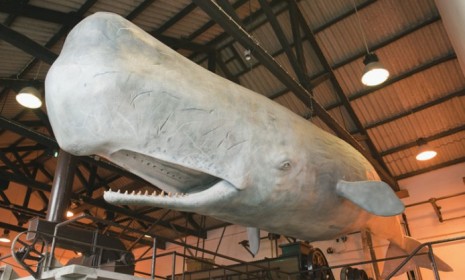
- Select a language for the TTS:
- UK English Female
- UK English Male
- US English Female
- US English Male
- Australian Female
- Australian Male
- Language selected: (auto detect) - EN
Play all audios:
Scientists have long theorized that millions of years ago, whales had legs, dividing time between land and sea. And now, findings from a new in-depth study — published in the _Journal of
Vertebrate Paleontology_ — may help experts fill in the evolutionary gap between the enormous sea-faring mammals of today and their (possibly) amphibious ancestors. Here's what you
should know: WHAT EXACTLY WERE SCIENTISTS STUDYING? An ultra-rare, 40-million-year-old specimen that "nearly wound up as a countertop," says Brian Switek at _Wired_. An Italian
marble cutter found a strange animal's skull nested in finely cut slabs of rock. The man thought he had discovered a dinosaur. He was wrong. SUBSCRIBE TO THE WEEK Escape your echo
chamber. Get the facts behind the news, plus analysis from multiple perspectives. SUBSCRIBE & SAVE SIGN UP FOR THE WEEK'S FREE NEWSLETTERS From our morning news briefing to a weekly
Good News Newsletter, get the best of The Week delivered directly to your inbox. From our morning news briefing to a weekly Good News Newsletter, get the best of The Week delivered directly
to your inbox. AND IT WAS AN ANCIENT WHALE SKULL? Yep. Researchers traced the stone's origin to a limestone quarry in Egypt's Tarfa Valley, and pieced the fossil back together
there. Though its bones "had been hacked into six pieces… because the cuts were so smooth," the skeleton was easily reconstructed, says Ed Yong at _Discover_. They dubbed the
animal _aegyptocetus tarfa_, which translates to "Egyptian whale from Tarfa." SO WHAT WAS THIS WHALE LIKE? The ancient whale belonged to a group of mammals related to modern
toothed whales and dolphins. Its skull was more than two feet long, and the creature itself likely weighed more than 1,400 pounds. It had a specially adapted skull that allowed it to hear
echoes underwater, and a nose structure that suggests it was able to smell — critical for tracking prey on land. Smell is a sense that most modern whales lack. Scientists cite this as proof
that these animals had "powerful legs that could support them on land as well as powering them through water." Though strangely, the legs were nowhere to be found. WHERE DID ITS
LEGS GO? They were probably eaten. "Toothmarks on its ribcage indicate it might have been attacked from its right flank," says Jennifer Welsh at _Live Science_ — similar to how
modern sharks ambush their prey. Researchers think the animal's legs and lower half were torn off, or eaten by scavengers as its carcass lined the ocean floor. SO WHALES DEFINITELY HAD
LEGS? Well, not definitely. But this evidence helps strengthen that case. Many scientists already thought modern whales evolved from hooved, deer-like creatures, and _aegyptocetus_ could
provide "valuable information about the transition from land to sea," says Yong. _SOURCES: Discover, Live Science, Wired_









